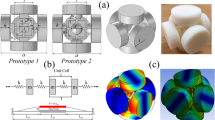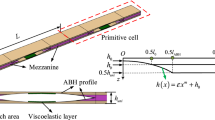Abstract
Phononic crystals embedded with acoustic black hole (ABH) structure have excellent performance absorbing structural waves in elastic bodies. However, it is not easy to be applied in practice because of the narrow sound absorption band. In this paper, we propose a new type of phononic crystal that embeds the acoustic black hole structure and destructive interference structure. The simulated and measured elastic wave transmission indicate that the vibration in the structure is reduced by 40 dB in the broad range of 100–50,000 Hz, which may provide a new path for wide-frequency vibration isolation and noise control.






Similar content being viewed by others
Data availability
The data sets analyzed during the current study are available from the corresponding author on reasonable request.
References
T. Yang, S. Hou, Z.-H. Qin, Q. Ding, L.-Q. Chen, J. Sound Vib. 494, 115629 (2021)
T. Yang, Z. Lin, T. Yang, Adv. Eng. Mater. 2022, 2200805 (2022). https://doi.org/10.1002/adem.202200805
M.A. Mironov, V.V. Pislyakov, Acoust. Phys. 48(3), 347 (2002)
H. Ji, J. Luo, J. Qiu, L. Cheng, Mech. Syst. Signal Process. 104, 19 (2018)
V.V. Krylov, F. Tilman, J. Sound Vib. 274(3–5), 605 (2004)
H. Ji, X. Zhao, N. Wang, W. Huang, J. Qiu, L. Cheng, J. Vib. Acoust.-Trans. Asme. (2022). https://doi.org/10.1115/1.4053475
H. Ji, N. Wang, C. Zhang, X. Wang, L. Cheng, J. Qiu, J. Sound Vib. 500, 116024 (2021)
J. Deng, O. Guasch, L. Zheng, J. Sound Vib. 458, 109 (2019)
L. Tang, L. Cheng, J. Appl. Phys. (2017). https://doi.org/10.1063/1.4983459
L. Tang, L. Cheng, Mech. Syst. Signal Process. 133, 106257 (2019)
X. Lyu, Q. Ding, T. Yang, Appl. Math. Mech.-Engl. Ed. 41(2), 279 (2020)
S. Kottayi, R. Althomali, T.M. Thasleema, N.K. Narayanan and Ieee: IEEE Int. Conf. Commun. Signal Process. (ICCSP), 2016, p. 73.
A. Arjunan, Mater. Today Commun. 19, 68 (2019)
J. Xu, X. Zhang, R. Yan, J. Appl. Mech. 87(9), 091001 (2020). https://doi.org/10.1115/1.4047205
W. Liu, B. Yi, G.H. Yoon, H. Choi, Adv. Eng. Mater. (2020). https://doi.org/10.1002/adem.202000645
J.Q. Sun, J. Sound Vib. 185(5), 827 (1995)
V.V. Krylov, J. Sound Vib. 468, 115100 (2020)
X. Lyu, H. Li, Z. Ma, Q. Ding, T. Yang, L. Chen, K.K. Zur, J. Sound Vib. 514, 116432 (2021)
J. Zhang, X. Zhang, H. Zhang, X. Bi, N. Hu, C. Zhang, J. Sound Vib. 530, 116945 (2022)
H. Meng, D. Chronopoulos, A.T. Fabro, W. Elmadih, I. Maskery, J. Sound Vib. 465, 115005 (2020)
S. Wang, S.-Y. Lin, Acta Phys. Sin. 68(2), 024303 (2019)
W. Wei, D. Chronopoulos, H. Meng, Materials. 14(17), 4759 (2021)
Acknowledgements
This work was supported by the Natural Science Foundation of China [Grant Number 12072221], the Fundamental Research Funds for the Central Universities [Grant Number 2013017] and the Ten Thousand Talents Program.
Funding
This research was supported by National Natural Science Foundation of China (Grant Nos. 12232014, 12072221).
Author information
Authors and Affiliations
Contributions
Pengfei Fu: conceptualization, methodology, software, data curation, writing—original draft. Xiaofei lyu: validation, investigation. Tianzhi Yang: conceptualization, funding acquisition, writing—review and editing. Li-Qun Chen: writing—review and editing.
Corresponding authors
Ethics declarations
Conflict of interest
We have no competing interests. All authors gave final approval for publication and agree to be accountable for all aspects of the work presented herein.
Additional information
Publisher's Note
Springer Nature remains neutral with regard to jurisdictional claims in published maps and institutional affiliations.
Rights and permissions
Springer Nature or its licensor (e.g. a society or other partner) holds exclusive rights to this article under a publishing agreement with the author(s) or other rightsholder(s); author self-archiving of the accepted manuscript version of this article is solely governed by the terms of such publishing agreement and applicable law.
About this article
Cite this article
Fu, P., lyu, X., Yang, T. et al. Wide-band vibration isolation induced by merging acoustic black holes and destructive interference. Appl. Phys. A 130, 416 (2024). https://doi.org/10.1007/s00339-024-07540-5
Received:
Accepted:
Published:
DOI: https://doi.org/10.1007/s00339-024-07540-5




